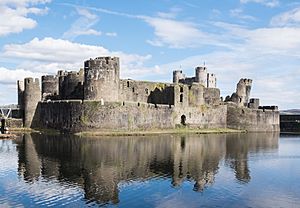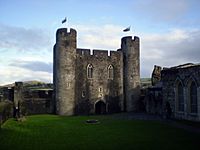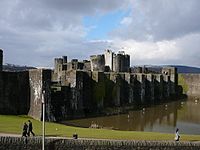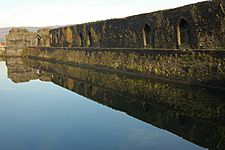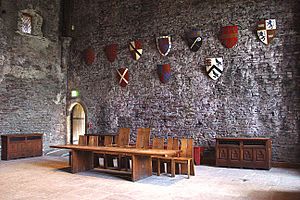Caerphilly Castle facts for kids
Quick facts for kids Caerphilly Castle |
|
|---|---|
| Part of the Caerphilly County Borough | |
| Caerphilly, Wales, United Kingdom | |
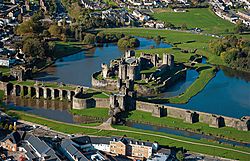
Caerphilly Castle and moat
|
|
| Type | Medieval concentric castle |
| Area | Around 30 acres (12 ha) |
| Site information | |
| Owner | Cadw |
| Condition | Ruined, with partial restoration |
| Site history | |
| Built | 1268–1290 |
| Built by | Gilbert de Clare |
| In use | Open to public |
| Materials | Pennant Sandstone |
| Events | Welsh Wars Invasion of England English Civil War |
|
Listed Building – Grade I
|
|
Caerphilly Castle (Welsh: Castell Caerffili) is a medieval castle in Caerphilly in South Wales. The castle was built by Gilbert de Clare (husband of Joan of Acre - daughter of the newly crowned King Edward I) to help him in his quest to control Wales. It is the largest castle in Wales, occupying around 30 acres (12 ha). The castle lay near a former Roman fort in a basin of the Rhymney Valley. Gilbert built the castle beside the Rhymney River and at the heart of a network of paths and roads.
Two things that make it famous are its gatehouses and its concentric rings of walls (smaller circles around the middle to larger circles on the outside). The castle also has water defenses. It is now a tourist attraction.
Contents
History
13th and 14th centuries
Gilbert de Clare (also known as "Red Gilbert" because of his red hair) inherited his family's lands and continued to fight to conquer all of the Glamorgan region in southeast Wales. He defeated Llywelyn ap Gruffudd, the last Prince of Wales, between 1266 and 1267. He began building the castle to control his new land in 1268. Llywelyn ap Gruffudd continued to fight English rule and tried to keep the castle from being built. It was mostly completed by 1271. When Llewelyn was killed in 1282, Caerphilly was made into the palace of the de Clare family.
Gilbert's son, also named Gilbert de Clare, inherited the castle, but he died fighting at the Battle of Bannockburn in 1314 while still quite young. His sister Eleanor inherited Caerphilly.
The last fighting the castle saw was during the war between King Edward II and Queen Isabella. the Queen besieged the castle from December 1326 through March 1327.
15th – 17th centuries
In 1416, the castle passed through Isabel le Despenser in marriage to her first husband Richard de Beauchamp, the earl of Worcester, and then to her second husband, Richard Beauchamp, the earl of Warwick. Isabel and her second husband spent a fortune repairing the castle and making it their main home in the area.
The castle passed to Richard Neville in 1449 and to Jasper Tudor, the earl of Pembroke, in 1486.
After 1486, the castle went into decline because the new, more fashionable Cardiff Castle was built. Once the sluice-gates were in poor condition, the water defenses probably drained away. Henry Herbert, the earl of Pembroke used the castle for his manorial court. In 1583, the castle was leased to Thomas Lewis, who damaged it by taking stone from it to extend his house.
18th – 21st centuries
In 1776, John Stuart (later the first Marquess of Bute) married into the Pembroke family and inherited Caerphilly Castle. He protected the castle from further decline. His great-grandson John Crichton-Stuart, the third marquess, began making improvements to the castle.
The fourth marquess, John Crichton-Stuart, continued restoring the castle between 1928 and 1939. By 1947, when John Crichton-Stuart, the fifth marquess, inherited the castle, the Bute family had gotten rid of most of its land in South Wales. John sold off the family's remaining property interests and in 1950 he gave Caerphilly Castle to the state. The lakes were re-flooded and the final stages of the restoration work were completed in the 1950s and 1960s. In the 21st century, the castle is managed by the Welsh heritage agency Cadw as a tourist attraction. It is protected as a scheduled monument and as a grade I listed building.
Architecture
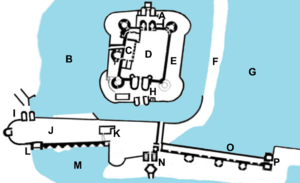
Caerphilly Castle is the second largest castle in Britain. It sits on 30 acres (120,000 m2) of land. Caerphilly is built on a natural gravel bank in the local river basin.
The design of the castle is the first of its kind in Britain. The walls, which are made with Pennant sandstone, are built in concentric circles around the castle. The castle has seven gatehouses that protect it: The North and South Gatehouses are on the east side in the outer wall. The Outer Main Gatehouse is between the North and South Gatehouses. It is the main entrance to the castle grounds. The next set of walls inside the outer walls contains the Outer East and Outer West Gatehouses. Finally, the castle itself has the Inner East and Inner West Gatehouses.
The castle has many water defenses. It has moats, dams, and lakes around it. The North Lake is where the North Gatehouse is, and the South Lake is where the South Gatehouse is. Moats separate inner walls from outer walls. Drawbridges were used to cross the moats. Four replica siege engines have been placed on display near the South Dam.
The central island has the shape of a square with towers on all four corners and another tower on the south side of the castle. Inside the inner ward was the castle's Great Hall. It had a large, central fireplace and was decorated with the finest decorations. To the east of the Great Hall was the castle chapel, positioned above the buttery and pantry. On the west side of the hall were the castle's private living areas.
Past the central island was the Western Island, probably reached by drawbridges. The island is called Y Weringaer or Caer y Werin in Welsh, meaning "the people's fort." It may have been used by the town of Caerphilly for protection during battles. There is a 3 acres (1.2 ha) plot of land northwest of the Western Island that is a former Roman fort.
Interesting facts about Caerphilly Castle
- Caerphilly is the largest castle in Wales and the second-largest in Britain.
- Most of the castle was built in only three years (1268-1271).
- It was built while the last king of Wales, Llywelyn ap Gruffudd, was attacking it.
- The ghost of Gilbert's wife Alice is said to haunt the castle. She is called the "Green Lady."
- The southeast tower leans at approximately 10 degrees, which is more than the famous Leaning Tower of Pisa.
- The castle has been used in the filming of many shows, including Doctor Who.
- There a dragon’s lair at the castle with a 13-foot-long storytelling dragon and family who will tell you The Cadw Dragons’ Tale.
- People still get married in the Great Hall.
- The castle hosts the Big Cheese Festival in the summer.
Images for kids
See also
 In Spanish: Castillo de Caerphilly para niños
In Spanish: Castillo de Caerphilly para niños


